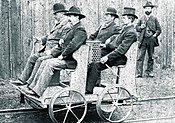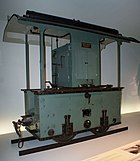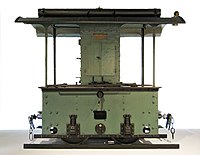Daimler petroleum railway
The vehicles of the Daimler Petroleum Railway were the first rail vehicles with a gasoline engine . Historical original vehicles for the transport of people and goods are exhibited in the Mercedes-Benz Museum in Stuttgart - Bad Cannstatt .
history
Motorized trolley
The pioneer of automobile construction, Gottlieb Daimler , developed a railroad trolley powered by a combustion engine in 1887 . It was the world's first rail vehicle with a gasoline engine. It was driven by the small, high- speed motor, the so-called grandfather clock , and was first tested in the summer of 1887 between Esslingen and Kirchheim / Teck .
| cylinder | 1 |
| Displacement | 462 cc |
| power | 1.1 HP (0.8 kW) |
| rotational speed | 650 rpm |
| Top speed | 20 km / h |
| Seats | 4th |
Motor-Waggonet
On the occasion of the Cannstatter Volksfest in 1887, Gottlieb Daimler demonstrated a narrow-gauge railway powered by an internal combustion engine . It attracted a great deal of attention when it came to passenger transport between Wilhelmsplatz and Kursaal . From 1890 he sold an improved version under the name Waggonet . The high -speed two - cylinder V-engine from Daimler had an output of 1.5 kw (si2.0 hp). This enabled the vehicle , which weighed just under 700 kg, to travel at a speed of 20 km / h. There was a bench seat with 6 seats on each side of the car. The driver sat at the rear end on a saddle, in front of which the drive motor was installed in a box.
From May 14th to October 30th, 1890, the agricultural and forestry exhibition took place in Vienna on the Rotunda grounds. The organizers wanted to give the public easy access. The entrepreneur Josef Bierenz built and operated a motorized tram with Daimler wagons from Praterstern to the west entrance of Rotundenplatz. It was in operation all summer and carried thousands of passengers during that time . With a trailer, it offered space for 24 people. In the archive of the Technisches Museum Wien , which is not accessible to the public , a vehicle has been preserved in its original condition.
A steam train from the Praterstern proposed by the French narrow-gauge railway manufacturer Paul Decauville for exhibition was not approved. His steam trains, which were demonstrated in the previous year, 1889, on the Decauville Railway at the Paris World Exhibition (1889) were used worldwide for passenger and freight transport. He exhibited one of his cars in the French pavilion at the Vienna exhibition.
| cylinder | V2 |
| Displacement | 1026 cc |
| power | 2 HP (1.5 kW) |
| rotational speed | 620 rpm |
| Top speed | 20 km / h |
| Seats | 10 |
Motor locomotive
A more powerful variant was the engine locomotive with 4.6 hp (3.4 kW). The example on display in the Mercedes Museum was used as a light rail locomotive until 1918.
| cylinder | V2 |
| Displacement | 1902 cc |
| power | 4.6 HP (3.4 kW) |
| rotational speed | 580 rpm |
| Top speed | 16 km / h |
Web links
Individual evidence
- ↑ Motorized Draisine.
- ↑ a b c Thomas Winkler: Daimler Motorwagen.
- ^ Josef Nagler: Blätter für Technikgeschichte, Volume 22. Springer-Verlag, 1960, page 132
- ↑ Daimler Waggonet.
- ↑ Motor locomotive.






